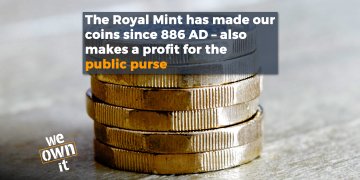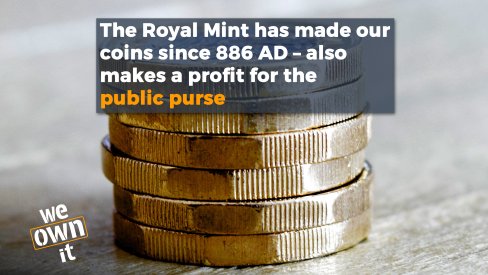The Royal Mint: public ownership since 886 AD
When you jangle loose change in your purse or wallet, you probably don't think about where those coins come from. Over a thousand years of craftsmanship have created them. The Royal Mint is Britain's oldest business!
In 886 AD the London Mint became a single institution. Its first ever coin was a silver penny of Alfred the Great, struck during the resettlement of London after Viking occupation. In 1279 the Mint was moved to the Tower of London. In 1696, Sir Isaac Newton took up the post of Warden of the Mint, responsible for investigating cases of counterfeiting. In 1870 the Chancellor took over the role of Master of the Mint.
In 1968, the Royal Mint moved from London to Llantrisant in Wales. In 1971, the UK's currency changed to 100 pennies in a pound on 'Decimal Day' - this involved years of planning and a public information campaign!
The Royal Mint manufactured 4,700 medals for the London 2012 Olympic and Paralympic Games. And in 2016, the Royal Mint Experience opened its doors to the public. Learn more about the history of the Royal Mint.
Today the Royal Mint makes coins for countries around the world as well as the UK, and makes a profit for the public purse.
Who owns the Royal Mint?
We do! The Royal Mint is our oldest publicly owned institution.
The Royal Mint Ltd is a government owned company, owned by HM Treasury through an executive agency, the Royal Mint Trading Fund. It was threatened with privatisation in 2009 when Alistair Darling (then the Chancellor of the Exchequer) began planning to sell it off, and again in 2015 when George Osborne considered doing this. Luckily, those plans were dropped - phew!
The Royal Mint has been proving that public ownership goes hand in hand with high quality and innovation for 1,130 years.
Key facts
- The Royal Mint is one of the largest employers in Wales, developing skills and building careers.
- Every year it makes millions in profit for the public purse - £18 million operating profit in 2021-22.
- Last year the Royal Mint made 1.55 billion coins and blanks for 22 countries around the world and 339 million coins for the UK.
- In 2023, it will open its new sustainable precious metals factory. This will process thousands of tonnes of electronic waste every week, helping to make the UK a leader in the circular economy.
- The Royal Mint has also started producing jewellery. '886 by The Royal Mint' is the first luxury jewellery brand in the world to use gold recovered from electronic waste like laptops and phones.
Show your support for public ownership - share this page!
Photo credit: William Warby


